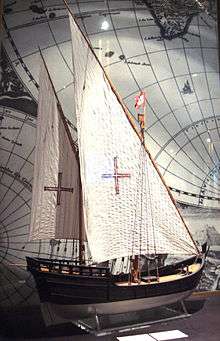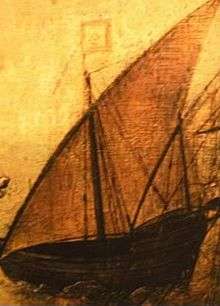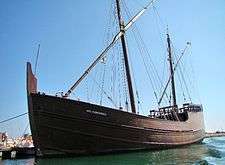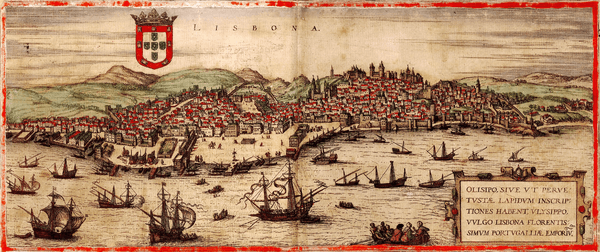Caravel
The caravel (Portuguese: caravela, IPA: [kɐɾɐˈvɛlɐ]) was a small, highly manoeuvrable sailing ship developed in the 15th century by the Portuguese to explore along the West African coast and into the Atlantic Ocean. The lateen sails gave it speed and the capacity for sailing windward (beating). Caravels were used by the Portuguese and Castilians for the oceanic exploration voyages during the 15th and 16th centuries in the Age of Discovery.

Etymology
Its English name derives from the Portuguese caravela, which in turn may derive from the Arabic qārib, used to refer to an ancient boat type known as carabus in Latin or καραβος in Greek, perhaps indicating some continuity of its carvel build through the ages.[1]
History


Until the 15th century Europeans were limited to coastal navigation. They used the barge or the balinger (barinel), which were ancient cargo vessels of the Mediterranean Sea with a capacity of around 50 to 200 tons. These boats were fragile, with only one mast with a fixed square sail that could not overcome the navigational difficulties of southward oceanic exploration, as the strong winds, shoals and strong ocean currents easily overwhelmed their abilities.
The caravel has origins in earlier Portuguese fishing boats built in the 13th century based on the medieval Islamic qarib.[2] The caravel was developed in about 1451, based on existing fishing boats under the sponsorship of Henry the Navigator of Portugal, and soon became the preferred vessel for Portuguese explorers like Diogo Cão, Bartolomeu Dias or Gaspar and Miguel Corte-Real, and by Christopher Columbus. They were agile and easier to navigate than the barca and barinel, with a tonnage of 50 to 160 tons and 1 to 3 masts, with lateen triangular sails allowing beating. Being smaller and having a shallow keel, the caravel could sail upriver in shallow coastal waters. With the lateen sails attached, it was highly maneuverable and could sail much nearer the shore, while with the square Atlantic-type sails attached, it was very fast. Its economy, speed, agility, and power made it esteemed as the best sailing vessel of its time. The limited capacity for cargo and crew were their main drawbacks, but did not hinder its success.
The exploration done with caravels made the spice trade of the Portuguese and the Spanish possible. However, for the trade itself, the caravel was later replaced by the larger carrack (nau), which was more profitable for trading. The caravel was one of the pinnacle ships in Iberian ship development from 1400–1600.
Design
Due to its lighter weight and thus greater speed, the caravel was a boon to sailors. Early caravels generally carried two or three masts with lateen sails, while later types had four masts. Early caravels such as the caravela tilhada of the 15th century had an average length of between 12 and 18 m (39 and 59 ft), an average capacity of 50 to 60 tons,[3] a high length-to-beam ratio of around 3.5 to 1, and narrow ellipsoidal frame (unlike the circular frame of the nau), making them very fast and maneuverable but with somewhat low capacity. It was in such ships that Christopher Columbus set out on his expedition in 1492; Santa María was a nau of about 100 tons which served as the flagship and the Pinta and Niña were smaller caravels of around 15–20 m with a beam of 6 m and displacing around 60–75 tons.
Square-rigged caravel

Towards the end of the 15th century, the Portuguese developed a larger version of the caravel, bearing a forecastle and sterncastle – though not as high as those carracks, which would have made it unweatherly – but most distinguishable for its square-rigged foremast, and three other masts bearing lateen rig. In this form it was referred to in Portuguese as a "round caravel" (caravela redonda) as in Iberian tradition, a bulging square sail is said to be round.
It was employed in coast-guard fleets near the Strait of Gibraltar and as an armed escort for merchant ships between Portugal and Brazil and in the Cape Route. Some consider this a forerunner of the fighting galleon and remained in use until the 17th century.

See also
- Iberian ship development, 1400–1600
- Notorious - a replica caravel in Australia
- Portuguese India Armadas
- Carrack, a type of round ship used in voyage to East India
- Lateen sail, a type of sail that can be used to sail against the wind
- Tanja sail, a precursor type of sail with the same ability
- Square rig
References
- Sleeswyk, André W. (1998). "Carvel-planking and Carvel Ships in the North οf Europe". Archaeonautica. 14: 223–228 (224f.).
- Hobson, John M. (2004). The Eastern Origins of Western Civilisation. Cambridge University Press. p. 141. ISBN 9780521547246.
- Russell, Peter E. (2000). Prince Henry 'the Navigator': A Life. Yale University Press. p. 229. ISBN 0-300-09130-3.
External links
| Look up caravel in Wiktionary, the free dictionary. |
- The History and Development of Caravels - A Thesis - George Robert Schwarz, B.A., University of Cincinnati, Chair of Advisory Committee: Dr. Luis Filipe Vieira de Castro, May 2008
- Museu da Marinha (in Portuguese)
- Museu da Marinha, fac-similes, (in Portuguese)
- Instituto Camões. Caravela
- Durchbruch am Kap des Schreckens dir. Axel Engstfeld, Germany 2002, 52m. ZDF (in German)